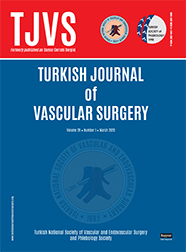
The Turkish Journal of Vascular Surgery
Yazarlar: Nezihi KÜÇÜKARSLAN, Sibel POÇAN, Mehmet YILMAZ, Alper UÇAK, Mutasim SÜNGÜN, Melih Hulusi US, Yücesin ARSLAN, Ahmet Turan YILMAZ
Konular:-
Anahtar Kelimeler:AV fistula; venous hypertension; jugular catheter
Özet: Objective: Arteriovenous (AV) fistula may cause hemodynamic complications in patients who have hemodialysis treatment for chronic renal failure. In this study our aim is to review the reasons of venous hypertension complication that occurs in the patients who have AV fistula in the upper extremities and also to suggest some methods of treatment. Material and Method: 184 patients who had AV fistulas for hemodialysis access between January 1996-July 2004 (mean 22± 5 months) are followed prospectively for venous hypertension complication binding to AV fistula operation. We used physical examination, venous Doppler ultrasonography and venography for diagnosis. Results: In our study group; the mean of age was 46.6. 184 (78%) cases had radiocephalic end-to-side, 14 (6%) cases had Snuff- Box end-to-side, 12 (5%) cases had brachiocephalic 6mm PTFE greft end-to-side, 14 (6%) cases had end-to-side brachiocephalic, and 12 (5%) cases had side-to-end brachiocephalic AV fistulas. Totally we opened 236 fistulas and in 8 cases (3.38%) venous hypertension developed. 6 (2.54%) of them were side-to-side radiocephalic and 2 of them (0.8%) were end-to-side radiocephalic AV fistulas. We diagnosed incomplete subclavian venous thrombosis in 2 cases (0.8%) end-to-side radiocephalic anastomosis. In the history of 1 case who has pain and edema in his upper extremity (0.32%) we found out that 2 days ago his subclavian venous catheter had been pushed out. Conclusion: Before opening an AV fistula, we have to apply colored venous Doppler ultrasonography to the patients who had subclavian venous catheterization in his history. If there is any suspicion in history, we have to apply venography. We do not suggest end-to-side anastomosis method. If venous hypertension occurs because of this method, we suggest distal venous ligation on the anastomosis line. (Turkish J Vasc Surg 2004;13(3):17-20).